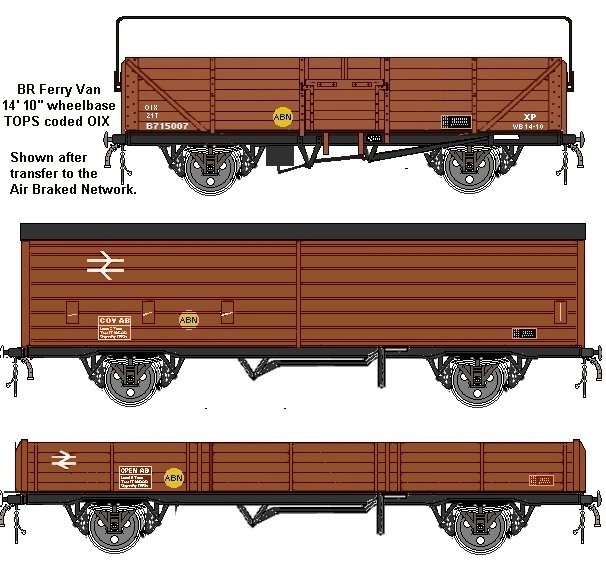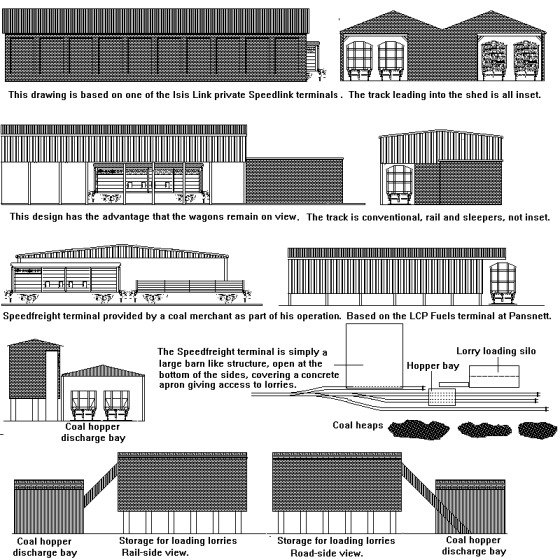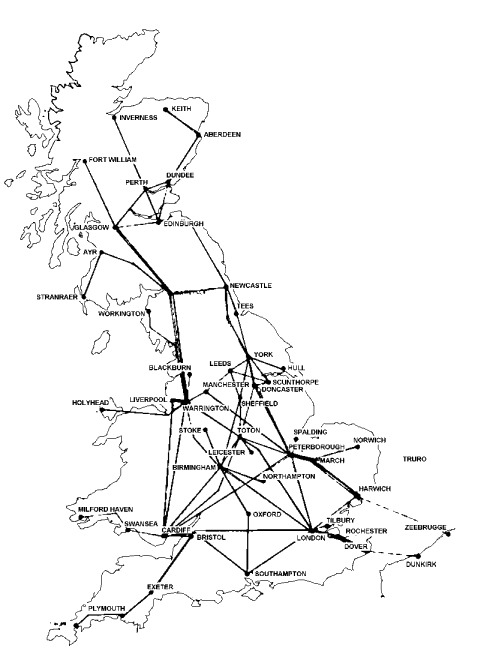Vehicles for use on the air brake network were marked with a yellow circle about a foot in diameter containing the letters ABN in black. The original Farish VAA van had this marking (actually the model is a VAB, non ventilated). This marking was normally placed toward the left hand end of the body side but I have seen an open wagon (OAA I think) with the marking more or less centrally placed. In later years, possibly following repaints or repairs the ABN occasionally appeared on a rectangular yellow patch slightly larger than the lettering rather than the full circle, but by this time the marking was redundant.
Fig___ ABN Markings

Air braked network trains were made up of all air braked stock but in the residual vacuum braked network air braked vehicles were quite often seen. As only a proportion of air braked stock was piped for vacuum brake operations the air braked vehicles would usually be marshalled to the rear to allow the vacuum brakes on the remaining wagons to be connected to the loco. As more locomotives were fitted with air brakes the air braked wagons appeared at the front if they outnumbered the vacuum braked wagons. Mixed rakes always had a break van at the rear even after they had been abandoned on fully-fitted trains.
Fissons the fertiliser people were based near Bristol and were amongst the first to use the regular all-air-braked freight service running from Bristol to Glasgow. By the mid 1970's the British Rail all-air braked service network covered the whole country with its main axis as the west coast main line. Services from Bristol ran to Glasgow and Manchester, services from Swansea and Cardiff ran to London, Barking, East Anglia and Warrington, ferry traffic ran from Dover via London up to Dundee and from Harwich via the yards at March to Manchester. Leeds was a major hub handling the Birmingham to Tyneside traffic and on the route for services from Glasgow to Humberside and Manchester. The air braked trains served twenty five major freight handling depots run by British Railways and from the early 1970's freight handling companies such as William Cory & Sons and Isis Link opened their own depots (which offered lower handling costs).
In 1977 the government allowed further investment in the air braked goods network and in September of that year the name Speedlink was first used in connection with air braked goods services.
British Rail air braked rolling stock was essentially conventional, open wagons and vans, with specialised vehicles such as tank wagons, hoppers and car carriers leased from third party operators. In spite of offering extremely competitive pricing the take up on this service was not encouraging so the train-ferry services (which all used air-brakes for compatibility with Continental railways), were brought into the scheme. One of the problems was the physical size of the new vans, by the mid 1970's palletisation was really beginning to catch on but the Cov AB internal dimensions did not match well with standard size pallets. Some users were prepared to build non-standard pallets for the service but obviously this was a cost and convenience factor which discouraged potential customers. Later designs of vans addressed this problem and the very large VGA four wheeler (introduced in 1982) was actually quite a success. By the time the VGA vans arrived continental designed vans, arriving via the ferry services, were proving successful. These continental wagons were hired for use within the UK and a number of wagon leasing firms built or purchased similar wagons, scaled specifically for British use.
Railfreight Distribution established the Speedlink Distribution service in 1983, the final development of the air-braked wagon-load network services. Speedlink dealt with single wagon load traffic and served road distribution centres (both railway and privately owned) and individual factory sidings (often paid for under the `Section 8' government grant system). Under the Speedlink system individual wagons were collected from the factories, warehouses or docks and taken to the nearest Speedlink regional centre, in effect a marshalling yard. They were then assembled into block trains and dispatched to the appropriate regional centre for distribution, where they were sorted and delivered. The collection and distribution are called `trip' workings and `trip working' is the nearest modern equivalent to a pick up goods service, although exclusively feeding private industrial sidings rather than a mix of these and station goods yards. Trip workings can include only a couple of vans or a rake of 20 or more vehicles. Incidentally where loco's are in short supply it is not unknown for the class 08 shunter to be used on these trip workings, and Network South East (Southern Region as was) up graded some of their 08's with a new gearbox to run at 20 mph specifically for this purpose.
There were a great many privately owned freight terminals, often benefiting from 'Section Eight Grants' to lay on the rail link. These generally featured quite large warehousing and often an outside mounted gantry crane, some however were simple covered concrete pads on which lorries could approach the rail wagons.
Fig ___ Private Speedlink Depots

In the Speedlink system stock was (theoretically) marshalled only twice, once at the originating regional centre and again, if required, at the receiving centre. This means the large marshalling yards became largely redundant and most were closed down.
The Speedlink network was originally based on 12 main marshalling yards; Glasgow (Mossend), Carlisle, Newcastle (Tyne), York (Dringhouses), Warrington, Leeds (Healy Mills), Doncaster, Toton, Whitemoor, Bescott Birmingham, Willesden and Severn Tunnel Junction. Each of these received at least one train each day from each of the others. In addition there were a series of smaller yards located in traffic centres which also provided services for non-Speedlink trains such as crew relief's and the like. In 1981 there were about two hundred of these smaller yards but the numbers were cut down over the years to under a hundred. The plan called for each train to spend no more than an hour shunting at each depot, wagons were collected by trip workings in the afternoons and evenings, hauled through the trunk network at night and delivered by trip workings before lunch the following morning.
Fig ___ Basic Speedlink network in the early 1980's

The above map was kindly faxed through to me by BR in the early 1980's, unfortunately when I came to trace it off I could not read the name of the town between Workington and Newcastle. By the time I looked at scanning it in and remembered this BR had been privatised.
The bulk of the Speedlink stock was built for palletised loads in vans or air-braked opens, private owners and leasing companies provided any tanker wagons for liquids as well as hoppers for bulk cargo. Small consignments of steel products were moved in Speedlink trains, these were generally finished goods such as pipes as block consignments of steel and other metals (mainly aluminium) fell under the train-load freight Metals sector. Various experimental wagon types were introduced for Speedlink services, mostly from the private sector, bringing with them new operating practices.
Wagon-load coal and scrap metal, both low value goods, did not fall under the Speedlink services at first and these remained as almost the last cargo for the tail end of the vacuum braked wagon load network. The intention was to move over to an all air braked goods vehicle fleet so the new hopper wagons for domestic coal (TOPS coded HBA) were fitted with air brakes and only piped for working with vacuum braked stock. Curiously, although air braked, the HBA wagons were designed to run at a maximum speed of 45 mph in line with the existing vacuum brake coal distribution services of the day.
In 1984 scrap metal and domestic coal distribution were both integrated into the Speedlink system. Scrap metal was to be carried in privately owned stock with a small quantity moved in Railway owned vehicles and domestic coal was to be carried in air braked HEA hopper wagons. The HEAs were converted from HBAs in 1983/84, the conversion consisted of re-springing the suspension to operate at 60 mph when loaded.
In the 1980's Cobra Containers introduced purpose built coal containers, essentially open topped ISO standard containers but built to a reduced height to cater for the British loading gauge. These were run on modified standard BR four wheeled air braked chassis coded FPA. Twenty foot types found favour with Kelly's for exports to Ireland from Wales and a thirty foot type was used by Russels in Scotland for domestic coal traffic. These coal containers are discussed in more detail in the section on 'Non Freightliner Air Braked Container Services'.
The domestic coal business continued to contract however, by 1990 there were no Network Coal services south of London and the remaining parts of the system ceased operating in 1993.
Speedlink, already burdened with the loss making ferry traffic, suffered further losses as the train-load sectors increasingly tagged their wagon load traffic onto their own trains for long hauls. In spite of the early promise and a number of healthy traffic flows Speedlink failed to achieve a working profit and after a number of rationalisations and cut backs the network was formally closed down in 1991. This was something of a blow to the British and continental wagon leasing and building firms and caused considerable anger amongst the companies who had been persuaded to pay towards the laying in of their own sidings.
In 1994 Transrail (one of the three pre-privatisation train-load haulage companies) re-introduced an all air braked wagon-load service under the working name of Enterprise. This area has seen further investment and aggressive business hunting by English Welsh and Scottish Railways, the privatised freight train operator. Although small in scale compared to Speedlink the Enterprise service is still growing and apparently turning in a steady profit. In the four years between 1994 and 1998 freight train movements increased by about 60%, although the ton-mile figure only increased by about 3%. This suggests that more short trains are being hauled through the network and possibly that rail is competing more effectively on shorter hauls for large loads. In 1998 I saw trains consisting of as few as three tank wagons on my local line, however if the cargo is sufficiently valuable this train may well have earned a profit albeit small.
The two restrictions on modern rail freight are the speed at which the trains operate and the clearances on the track which limit the size of the vehicles. Rolling stock design is the main limiting factor on speed for freight trains, by the late 1990's over ninety percent of freight trains were still timed to run at 60 mph or less, only about 120 paths for freight were timed for operation at over 70 mph. The exception to this is the Railnet postal services, with their new Class 325 multiple units, all 60 of the daily Railnet services are timed to operate at over 90 mph.
There are plans to increase the clearances on several key routes to allow wagons carrying road trailers to operate. The plan was that by the end of the 1990's most main lines could handle containers up to eight foot six inches high. This would allow the use of purpose built lower than normal road trailers carried on low-loading wagons. For dense cargo the size restriction of the road trailers is less of a problem, rail can carry a healthy tonnage of tinned foods for example as well as the more common steel and minerals. The Eurospine wagons purchased by EWS are run as 'Enterprise' workings, attached to the existing Enterprise services.